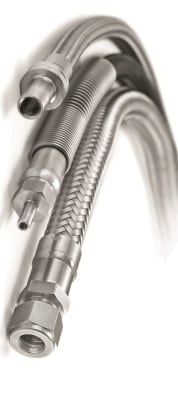Are Your Hoses STAMPED?
Are Your Hoses STAMPED?
The right hose keeps your process performing safely and cost effectively. The wrong hose could undermine your process, put personnel at risk, and compromise your bottom line – sometimes without you being aware of it. However, choosing the correct hose for your application can be difficult as there are many system variables to evaluate. Additionally, when it comes to product configuration, there are four main components of a hose – core tube material and construction; reinforcement layers; end connection type and material; and hose covers – with countless options for each to consider.
A Closer Look: Why Choose Hose
Rigid materials, such as piping and tubing, must be installed straight, perpendicular, or at angles cut perfectly to the exact lengths required. While there are many advantages to installed tubing systems, there will always be a variable or dynamic element to a well performing fluid system. Compound directions require exact lengths and numerous connections. Because hose lends itself to convenient bending and routing, system designers can eliminate many of the connections required when using rigid materials. The benefits that stem from fewer connections are:
- Lower cost of materials and labour
- Reduced risk of leakage
- Less chance of pressure drop
- Less chance for entrapment of the system media
Additionally, hose will compensate for slight dimensional mismatches between connection points. Hose can also be easily removed or replaced for periodic cleaning or maintenance which is big advantage over rigid tubing system installations.
Make Sure Your Hoses are STAMPED
When you’re ready to select the right hose, it often helps to use the STAMPED method to make sure you’re specifying the correct hose for your application.

Size: determine the ID, OD, live length and overall length in order to meet system flow requirements.
Temperature: identify the minimum and maximum temperatures to which the assembly will be exposed. It’s important here to consider both the temperature of the system media, but also the ambient, external temperature.
Application: is the hose application going to be Dynamic (could flex or otherwise change position while in use) or Static (remain stationary and not move or vibrate in any plane)?
Material: select materials that are going to be suitable and compatible with your system media.
Pressure: identify the minimum and maximum pressures (or vacuum) within and outside the hose assembly.
End Connections: style, type, orientation, and attachment methods must be considered for integrating hose into your system design.
Delivery: what are your testing, quality, packaging and delivery requirements?
A Local Partner With Global Capabilities
How fast do you need it? We stock a range of high quality hose and flexible tubing products that can be built and customized to your exact requirement. Our Vancouver location is the home of our Hose Fabrication Cell where we manufacture many of our PTFE and PFA core hose assemblies using proprietary radial crimp technology to permanently attach end connections to hose. We also provide all metal hose assemblies, manufactured to Swagelok specifications in Cleveland, with welded end connections in accordance with ASME Boiler and Pressure Vessel Code Section IX. Whether radially crimped, manually welded, or welded using our proprietary cap-weld technology, every Swagelok hose assembly, in every location assembled, uses the same equipment, the same tight tolerances, and the same high quality standards and standard work practices that you’ve come to expect from us.
Cost of Ownership
You need to make decisions based on the true cost of a hose, which is the purchase price plus the cost of owning and maintaining, or replacing the assembly, over time. All hoses wear out. To help you determine how often hose replacement will be necessary, as well as understand maintenance and the cost of replacement, trust our Hose Advisory Service (HAS). From areas of focus to the complete facility, our highly trained advisors walk the floor with you to fully understand your operation and learn what an optimized fluid system means to you. From there, we deliver a scalable inspection and reporting process designed for your needs. You’ll get a detailed report, backed by recommendations on best maintenance practices and schedules, along with any modifications that can make an impact in your facility. Our promise is to keep the communication going before, during, and after the inspection process to give you the training, education, and solutions you need.


